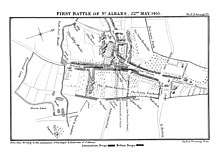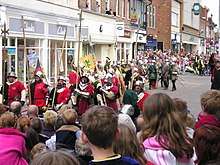First Battle of St Albans
The First Battle of St Albans, fought on 22 May 1455 at St Albans, 22 miles (35 km) north of London, traditionally marks the beginning of the Wars of the Roses in England.[4] Richard, Duke of York, and his allies, the Neville earls of Salisbury and Warwick, defeated a royal army commanded by Edmund Beaufort, Duke of Somerset, who was killed. With King Henry VI captured, a subsequent parliament appointed Richard of York Lord Protector.[5]
| First Battle of St Albans | |||||||
|---|---|---|---|---|---|---|---|
| Part of the Wars of the Roses | |||||||
 | |||||||
| |||||||
| Belligerents | |||||||
|
|
| ||||||
| Commanders and leaders | |||||||
|
| ||||||
| Strength | |||||||
| 3,000–7,000[2] | 2,000[3] | ||||||
| Casualties and losses | |||||||
| 60[3] | 100[1] | ||||||
Background
The incapacitation of Henry VI by mental illness in 1454 had led to the recall to court of Richard of York, his closest adult relative. Back in 1447, York had been assigned as Lieutenant of Ireland, basically in exile away from England, while his long time rival, Edmund Beaufort, Duke of Somerset, and favorite of the king, had been given the charge of the Lieutenancy of France. After Somerset's own failure in France, York unexpectedly returned to London with significant support not only from the nobility, most of whom saw the incompetence of Somerset's efforts in France, but also from the public. He presented himself as a champion of the law and urged the King to have Somerset tried and held accountable for his failures. He also wished to be recognised as heir presumptive to the English throne while Henry VI was childless. York formed an armed force to force the issue in 1452, and after meeting with the council of war and the King, who desperately wanted to avoid a conflict, York's demands were agreed on. York disbanded his army as a result, but was soon arrested and held prisoner for three months. An execution was avoided as the King was nervous about arousing trouble; the Duke of York was very popular and known as a man of honour. York was only released after he agreed to swear an oath at St. Paul's Cathedral that he would never again take up arms against the King.
After the English army led by Sir John Talbot, 1st Earl of Shrewsbury, was routed in the Battle of Castillion, Henry VI suffered a complete mental breakdown and was unable to perform his royal duties. Somerset had attempted to take control of the country and sought to make himself Lord Protector. However, Somerset underestimated the Duke of York's influence and popularity, as many nobles on the council (including York's closest allies, his brother-in-law Richard Neville, Earl of Salisbury and Salisbury's son Richard, Earl of Warwick) were on York's side. And so York was given the appointment to govern England as Lord Protector and First Councillor of the realm while the king remained unfit. He used this position to move against his chief rival and express the bitterness which had accumulated over the years, and thus the Duke of Somerset was imprisoned. It was during this 14 months that the sides were clearly forming. There was conflict beyond that between the Dukes of York and Somerset; in fact, the two richest and most prominent families from the north, the Percys and Nevilles, were having their own conflicts. The Percys were, and still are to this day, the Earls of Northumberland; the Nevilles possessed both Salisbury and Warwick (received through the right of their wives) and they were one of the richest families in all England. The Nevilles were also related to the Duke of York by marriage, as the Duchess of York was Cecily Neville, the sister of the Earl of Salisbury. Much of the fighting was over land and money, but both were clearly choosing sides, the Percys for Somerset and the Nevilles for York.[6]
By Christmas of 1454, King Henry had recovered from his illness, removing the basis for York's authority.[7] Somerset was released and restored to his former position of power. Having reconvened the court at Westminster by mid-April 1455, Henry and a select council of nobles decided to hold a great council at Leicester. York and his closest allies anticipated that Somerset would bring charges against them at this assembly. They gathered an armed retinue and marched to stop the royal party from reaching Leicester, intercepting them at St Albans.
Fighting
The Lancastrian army of 2,000 troops arrived at St Albans first, with Humphrey Stafford, Duke of Buckingham, in command,[8] and proceeded to defend it[9] by placing troops along the Tonman Ditch and at the bars in Sopwell Lane and Shropshire Lane. The reassignment of Buckingham from Somerset as Commander of the Army had been a last minute decision by Henry VI, whether by fear of Somerset's past failures, or of animosity of the Duke of York. The 7,000-strong Yorkist army arrived and camped in Keyfield to the east. Lengthy negotiations ensued with heralds moving back and forth between the rival commanders.[10] After a few hours, it was believed in the Yorkist camp that King Henry VI knew nothing of the letters of negotiation.[3]
The Duke of York had made his intentions clear: he wanted Somerset punished and then executed. In a message to Henry VI he states:
"... surrender to us such as we will accuse, and not to resist til we have him which deserves death."[6]
This was dangerous territory that York was playing on, as he was demanding much from the King and setting the rules himself. The very act of displaying such an aggressive front to the King was treasonous, but his popularity kept York confident and supported. In a fit of uncharacteristic regency, Henry refused, replying:
"By the faith that I owe to St. Edward and the crown of England I shall destroy every mother's son and they shall be hanged, and drawn and quartered."[6]

_%2B_armies.png)
After several hours, Richard, despairing of a peaceful solution, decided to attack. Although his army might have been unwilling to attack King Henry, the Royal Standard was not visible[11] and might even have been negligently propped against a wall by the royal standard-bearer, the Earl of Wiltshire.[12] The bulk of Henry's forces were surprised by the suddenness of Richard's attack; most of the army was expecting a peaceful resolution similar to the one at Blackheath in 1452. However, two Yorkist frontal assaults down the narrow streets against the barricades near St Peter's Church, which were commanded by Lord Clifford,[13] made no headway and resulted in heavy casualties for the Yorkists.[1] The entire battle did not last longer than a half-hour and was due mostly to the element of surprise that Warwick placed charging into the town when the Lancastrians were unprepared.
Warwick led a reserve force through an unguarded part of the town's defenses, through back lanes and gardens. Suddenly the earl appeared in the market square where the main body of Henry's troops were talking and resting. There is evidence they were not yet expecting to be involved in the fighting, as many were not even wearing their helmets. Warwick charged instantly with his force, routing the Lancastrians.[14] Somerset, knowing very well that York would never let him live, had sought refuge at the Castle Inn. When the Yorkists surrounded the building, Somerset decided to try and fight his way out. He charged onto the main street, over the bodies of the defenders, and killed four men before being struck down. The Earl of Northumberland was killed trying to get to the refuge at Castle Inn. Lord Clifford of Skipton, an ally of Percy's, was hacked to death in the main street.
On the earl's orders, his archers then shot at the men surrounding the king, killing several and injuring the king and the Duke of Buckingham.[1] The Lancastrians manning the barricades realized the Yorkists had outflanked them and, fearing an attack from behind, abandoned their positions and fled the town.
Result
The first battle of St Albans was relatively minor in military terms, with fewer than sixty killed from approximately 5,000 combatants [15]. But politically this was a complete victory for York and the Nevilles: York had captured the king and restored himself to complete power, while Somerset and the Nevilles' northern rivals Henry Percy, Earl of Northumberland and Lord Clifford all fell during the rout.[1] Among the wounded were Buckingham, Thomas de Courtenay, Earl of Devon, Jasper Tudor (half-brother of the king), and Somerset's son Henry Beaufort, Earl of Dorset.[16] The sudden attack by and bravery of the 26-year-old Earl of Warwick began his famous military career and would lead to his reputation as "the Kingmaker".
The next day, York escorted King Henry back to London; York was appointed as Protector of England by the Parliament a few months later.[5]
In literature

Shakespeare's historic play Henry VI, Part 2 ends with the conclusion of this battle.
Trinity (known in the US as Margaret of Anjou), the second book of the Wars of the Roses series by Conn Iggulden, dramatises this battle as a moment of indecision for Richard of York but a powerful victory for the Neville faction in the Neville-Percy feud.
See also
- History of St Albans
- Second Battle of St Albans
- Percy-Neville feud
Notes
- Goodman, p. 24.
- Griffiths, p. 742.
- Griffiths, p. 744.
- Davies, p. 147.
- Hicks 2010, p. 114.
- Haigh, Philip A. (1995). The Military Campaigns of the Wars of the Roses. Surrey: Bramley Books. pp. 3–7. ISBN 978-1-85833-770-8.
- Hicks 2010, p. 107.
- Hicks 2010, p. 108.
- Goodman, p. 22.
- Bertram Percy Wolffe, Henry VI, (St. Edmundsbury Press, 2001), 292.
- Sadler (2011), p.7
- Sadler (2011), p.9
- Griffiths, p. 745.
- Hicks 2003, p. 35.
- Jones, p. 149.
- Hicks 2010, p. 110.
References
- Davies, C.S.L., "Government and Politics in England: problems of succession", in The Cambridge Historical Encyclopedia of Great Britain and Ireland, ed. Christopher Haigh, Cambridge University Press, 2000.
- Goodman, Anthony, The Wars of the Roses: Military Activity and English Society, 1452–97, London: Routledge & Kegan Paul, 1981, ISBN 978-0-7100-0728-5.
- Griffiths, R.A., The Reign of King Henry VI, University of California Press, 1981, ISBN 978-0-520-04372-5.
- Hicks, Michael, The Wars of the Roses 1455–1485, Essential Histories, 54, Osprey Publishing, 2003-04-20, ISBN 978-1-84176-491-7.
- Hicks, Michael, The Wars of the Roses, Yale University Press, 2010-10-26, ISBN 978-0-300-11423-2.
- Jones, Dan, The Hollow Crown: The Wars Of The Roses And The Rise Of The Tudors, Faber & Faber, 2015, ISBN 978-0-571-28808-3
- Sadler, John (2011). Towton: The Battle of Palm Sunday Field 1461. Pen & Sword Military. p. 60. ISBN 978-1-84415-965-9.
- Bertram Percy Wolffe, Henry VI, St. Edmundsbury Press, 2001.
Further reading
Burley, Elliott & Watson, The Battles of St Albans, Pen & Sword, 2007, ISBN 978-1-84415-569-9
| Wikimedia Commons has media related to First Battle of St Albans. |
